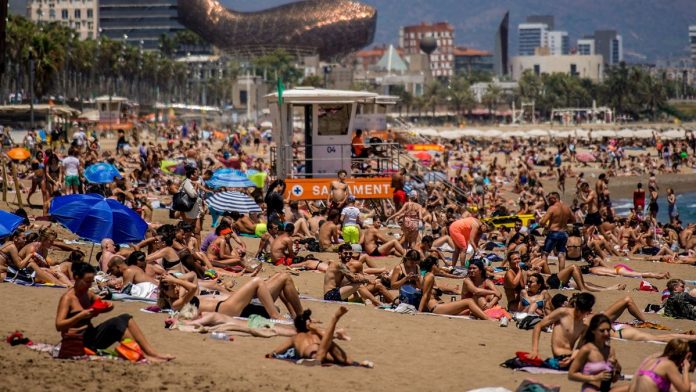As Barcelona exits its almost four-year-long drought, the aftermath has left many tough questions on the realities of water management and mass tourism.
Rain is falling consistently in Barcelona for the primary time in almost 4 years. Catalonia’s longest drought since records began is coming to an end, bringing the primary ‘normal’ spring and much-needed respite because the tourist season begins.
Because the reservoirs fill past their previously critically low condition, many tons of of 1000’s of festival goers will fly to Barcelona in May for Primavera Sound. It’s considered one of the biggest music festivals in all of Europe.
Because it begins its two-week run, Primavera Sound is the gunshot marking the start of the summer season which sees tourists flock to the Catalan capital from May until September.
And though recent rainfall has rescinded the region’s drought emergency, the experience has left many residents and officials wondering if the connection between Barcelona and tourism might be sustainable when the following drought inevitably comes.
Is tourism too big for water restrictions?
Primavera saw over 460,000 attendees from internationally in 2022 generating €349 million in revenue for the town of Barcelona.
Even amidst the worsening water situation throughout 2023, few restrictions were placed on the tourist sector. As the town closed out 2023 with over 12 million tourists having stayed in hotels, tourist lets and hostels, the Manager’s Office for Economy and Economic Promotion put tourist spending at €9.6 billion.
Tourism is considered one of the leading economic sectors for Barcelona and the encircling region, liable for greater than 10 per cent of local GDP in 2021, and accounting for five.4 per cent of Catalonia’s overall GDP in 2022.
Because the industry is so essential to the economy of the town, there have been many questions raised across the declaration of a drought emergency in February. As individual residents were limited to 200 litres of water per day, facing additional payments for exceeding this limit, there have been fewer restrictions for the tourism sector beyond emptying pools, advisory signs and water usage recommendations.
“We’re aware that water use awareness campaigns are being carried out within the hotel sector with the aim of creating customers aware,” Elvira Garcia, General Manager at Barcelona Oberta, a Union of commerce and tourism hubs in Barcelona told Euronews Green.
“On this sense, there are stickers or information in public toilets or a time of 4 minutes is beneficial for showering.”
What lessons have been learnt from the drought?
Even though it seems the worst is over, the drought has been a big a part of residents’ lives, even seeping into politics with candidates of the Catalan regional elections in May addressing the problem of water security.
Director of the Catalan Water Research Institute (ICRA), Vicenç Acuña Salazar, knows first-hand the inequalities that water scarcity has brought – especially within the tourist sector.
“The drought hasn’t finished officially, and we’ll see what happens, especially next fall. If the following fall is as dry because the last three falls then in winter we might be again in an emergency, and there might be shortages for just about all sectors, but for now, the summer is solved,” he explained to Euronews Green.
For Vicenç and lots of others, the necessity to inform tourists of water scarcity, in addition to establishing great autonomy from rainfall is a key think about making Barcelona less liable to future drought.
“We’re beginning to put together a gaggle of stakeholders from the touristic sector, people from the Spanish Association of Hotels and hopefully the Ministry of Environment from Spain and develop and implement a system for measuring water usage on tourist activities.”
“In order that every time you have got to decide on which hotel you have got to go to you possibly can see their water use efficiency, in the event that they have invested in recovering rainwater after which reusing it within the hotel, and these sorts of practices.”
How is Barcelona adapting to drought?
It’s a balancing act in Barcelona between concentrated periods of tourism through the summer and water usage through the worst months of the drought. It has highlighted how susceptible the town is to water shortages and why its tourism industry needs higher water management strategies.
The Catalan government will invest nearly €2.5 billion within the Catalan Water Agency (ACA) to administer water supplies and address future droughts. The plan, running from this yr until 2027, will triple previous investments, expanding the variety of water production plants from 24 to 40 and boosting production from Barcelona’s Besos River.
In 2024, a floating desalination plant might be installed off Barcelona’s coast, producing 14 hm³ of water annually – 6 per cent of the metropolitan area’s consumption – in addition to the constructing of 12 mobile desalination units deployed along the northern Costa Brava, starting in June.
These units, costing €10 million, will supply 1,000 m³ of water each day, covering 35 per cent of water consumption in over a dozen municipalities.
Recent rain has meant Barcelona has narrowly avoided effecting much change to its tourist sector, buying more time to arrange for the inevitable ‘next time’.
“Mass tourism shouldn’t be a part of the town strategy we would like. Corporations are aware that the trail is sustainability,” Elvira Garcia tells Euronews Green.
As increased heatwaves and more sparse rainfall affect much of Spain and the Mediterranean region, latest methods can have to be implemented to make sure the short-term advantages of tourism on the region’s economy and the long-term sustainability of water.
Unlock the world’s wonders with unforgettable journeys tailored just for you! Whether you crave sun-kissed beaches, thrilling adventures, or rich cultural escapes, your dream destination awaits. Enjoy seamless travel with expert tips, exclusive deals, and handpicked experiences that Turn Every Trip into a lifetime memory.










